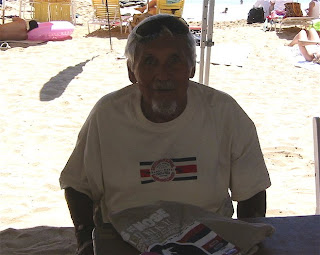Tonight we went to the Shingon Buddhist Mission in celebration of Bon Odori or Obon, "festival of the dead". It is when the dead souls or ancestors come back home to this world and visit their families. The Obon Festival is held each year throughout the United States at many Buddhist temples, one weekend, anywhere from mid-July to August.
People of all ages, races and color come for the big celebration.
The Shingon Mission of Honolulu was first built in 1917 and is now on the National Register of Historic Places. It may be the only temple with an outside alter. Two huge carved deities guard the main temple along with the bronze statue of the founder. At the alter are beautiful floral arrangements, food offerings and the blissful aroma of incense permeating the air.
The festival opens with a short prayer service atop a large wooden tower erected in the middle of the parking lot. There were taiko drummers, singers and vintage recordings of Obon music. The red paper lanterns hung overhead are to guide the spirits home and back. Men, women and children wearing "kimonos" or "yukatas" adorned many of the dancers, dancing to the repetitive traditional dances, around the tower. There were game booths for the children, food booths filled with many japanese style food~a killer 'poke-style' (bite size pieces of raw fish) sushi handroll and home-baked treats too.
I remember when I was a little girl in elementary school, my mom and dad would parade me to Gardena Buddhist church for Bon Odori practice, just like those hula lessons. After a few weeks of practice came the actual traditional dancing in the church's big parking lot or sometimes the streets in downtown Los Angeles. My younger cousins and I were costumed like little Japanese dolls~authentic silk kimonos and heavy obis around our waist with fan and "kachi-kachi's (castanet) tucked in our obis. We wore white tabi's (Japanese socks) and wedgie type Japanese slippers. Our hair pinned up with beautiful accessories to accent our face and we got to wear lipstick, just like the adults. Had I known then what I know now about the meaning behind the dance and festival, I probably would have made more of an effort to dance with a little more soul to it. Although I have forgotten the steps to the traditional dance of Bon Odori, I come to pay my respect to my ancestors, especially to my father, which also would have been his 81st birthday today. I hope they all have found their way home and back, knowing that I was there waiting for them.


 Duke Paoa Kahinu Mokoe Hulikohola Kahanamoku. The most famous athlete in Hawaiian history revered for his swimming and surfing accomplishments. A recipient of Olympic gold medals for swimming, Duke Kahanamoku was also the first to be inducted to both the Swimming Hall of Fame and the Surfing Hall of Fame.
Duke Paoa Kahinu Mokoe Hulikohola Kahanamoku. The most famous athlete in Hawaiian history revered for his swimming and surfing accomplishments. A recipient of Olympic gold medals for swimming, Duke Kahanamoku was also the first to be inducted to both the Swimming Hall of Fame and the Surfing Hall of Fame. 
 A painter, an illustrator and a photographer take their craft from art to artistry. An incredible feat of eye-candy that takes one into surrealism for MAC Make-Up Art Cosmetics Fall '09 Collection.
A painter, an illustrator and a photographer take their craft from art to artistry. An incredible feat of eye-candy that takes one into surrealism for MAC Make-Up Art Cosmetics Fall '09 Collection.












